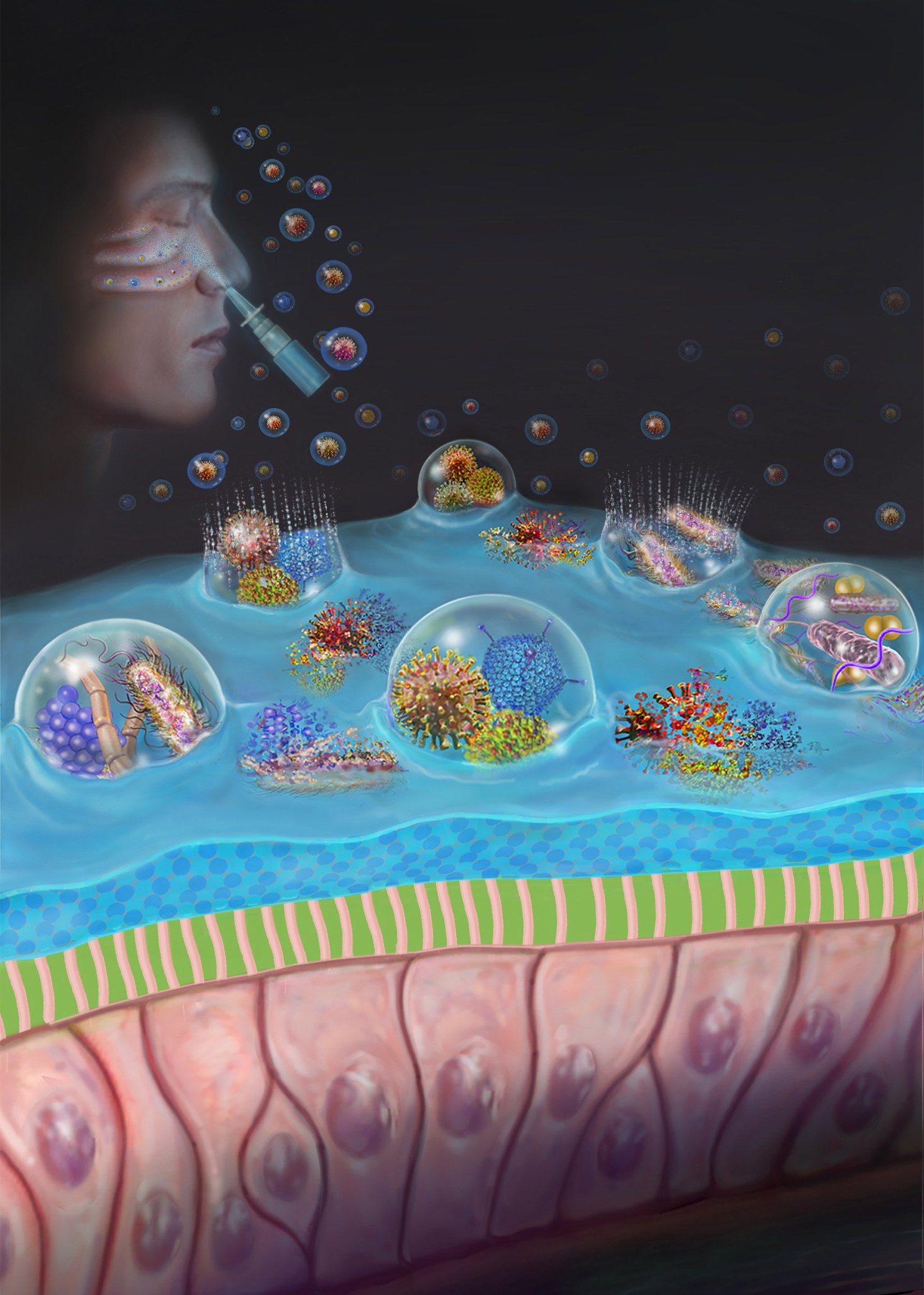The nasal spray coats the nasal cavity, capturing large respiratory droplets and serving as a physical barrier against a broad spectrum of viruses and bacteria, while effectively neutralizing them.
Courtesy of Randal McKenzie, McKenzie Illustrations
Health
Drug-free nasal spray blocks, neutralizes viruses, bacteria
In preclinical studies, spray offered nearly 100% protection from respiratory infections by COVID-19, influenza, viruses, and pneumonia-causing bacteria
A drug-free nasal spray that forms a gel-like matrix that captures and neutralizes germs may offer another layer of protection against respiratory infections, according to a study out of Harvard-affiliated Brigham and Women’s Hospital.
Based on preclinical studies, researchers at BWH say the broad-spectrum nasal spray is long-lasting, safe, and, if validated in humans, could play a key role in reducing respiratory diseases and safeguarding public health against new threats. The results are published in the journal Advanced Materials.
Most viruses enter our system through the nose. When we catch an airborne infection like the flu and COVID, we breathe out tiny droplets of fluids that contain the pathogen. Healthy people around us breathe in these pathogen-containing droplets, which attach inside their nose and infect the cells that line the nasal passageways. The pathogen replicates and can be released back into the air when an individual who is sick, whether they know it or not, sneezes, coughs, laughs, sings, or even just breathes.
Vaccines against these viruses can be beneficial, but they’re imperfect. Vaccinated people still get infected and spread the infection to others. Masks are also helpful but aren’t perfect, either — they can leak, and many people wear them improperly or choose not to wear them at all.
“The COVID pandemic showed us what respiratory pathogens can do to humanity in a very short time. That threat hasn’t gone away.”
Jeffrey Karp
“The COVID pandemic showed us what respiratory pathogens can do to humanity in a very short time. That threat hasn’t gone away. Not only do we have the flu to deal with seasonally, but we now have COVID, too,” said co-senior author Jeffrey Karp, distinguished chair in anesthesiology at BWH.
The new study details the research team’s efforts to create a nasal spray to defend against airborne respiratory illness.
“The spray, called Pathogen Capture and Neutralizing Spray (PCANS) in the paper, was developed using ingredients from the FDA’s Inactive Ingredient Database (IID), which have been previously used in approved nasal sprays, or from the Generally Recognized as Safe (GRAS) list of the FDA,” said co-senior author Nitin Joshi, an assistant professor of anesthesiology at BWH. “We developed a drug-free formulation using these compounds to block germs in three ways — PCANS forms a gel-like matrix that traps respiratory droplets, immobilizes the germs, and effectively neutralizes them, preventing infection.”
The researchers did the experiments detailed in the study under laboratory settings. They have not studied PCANS directly in humans. The researchers developed the formulation and studied its ability to capture respiratory droplets in a 3D-printed replica of a human nose. They showed that when sprayed in the nasal cavity replica, PCANS captured twice as many droplets as mucus alone.
“PCANS forms a gel, increasing its mechanical strength by a hundred times, forming a solid barrier,” said primary author John Joseph, a former postdoctoral fellow at BWH. “It blocked and neutralized almost 100 percent of all viruses and bacteria we tested, including Influenza, SARS-CoV-2, RSV, adenovirus, K Pneumonia and more.”
Experiments in mice showed that a single dose of the PCANS nasal spray could effectively block infection from an influenza virus (PR8) at 25 times the lethal dose. Virus levels in the lungs were reduced by >99.99 percent, and the inflammatory cells and cytokines in the lungs of PCANS-treated animals were normal.
“The formulation’s ability to inactivate a broad spectrum of pathogens, including the deadly PR8 influenza virus, demonstrates its high effectiveness,” said co-senior author Yohannes Tesfaigzi, AstraZeneca Professor of Medicine in the Field of Respiratory and Inflammatory Diseases at BWH. “In a rigorous mouse model study, prophylactic treatment with PCANS demonstrated exceptional efficacy, with treated mice exhibiting complete protection, while the untreated group showed no such benefit.”
While the study’s limitations include the lack of human studies of PCANS, it provides a strong foundation for future research to explore the full potential of PCANS in a broader context. The researchers are exploring whether PCANS can also block allergens, opening a potential new avenue for allergy relief.
For authorship and disclosures, visit the BWH website.
This study was supported by funding from the Gillian Reny Stepping Strong Center for Trauma Innovation at Brigham and Women’s Hospital, and the Department of Anesthesiology, Perioperative, and Pain Medicine at Brigham and Women’s Hospital.

